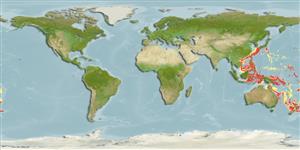Common names from other countries
Classification / Names / Names
Namen | Synonyme | Catalog of Fishes (gen., sp.) | ITIS | CoL | WoRMS
Environment: milieu / climate zone / depth range / distribution range
Ökologie
; tiefenbereich 100 - 1463 m (Ref. 409), usually 300 - 600 m (Ref. 409). Tropical, preferred 26°C (Ref. 107945); 33°N - 44°S, 103°E - 176°W
Indo-West Pacific: Madagascar to Japan and New Zealand (Ref. 8). Pérez Farfante recognizes 3 subspecies: Haliporoides sibogae australiensis from Australia; Haliporoides sibogae madagascariensis from Madagascar and Reunion; and Haliporoides sibogae sibogae from Malaysia to Japan and New Zealand (Ref. 75620).
Length at first maturity / Size / Gewicht / Alter
Maturity: Lm ?, range 10 - ? cm Max length : 16.5 cm BL Männchen/unbestimmt; (Ref. 8); 20 cm BL (female)
Both midwater and demersal species (Ref. 106892). Deep water species (Refs. 82143, 106892). On rocks and rubbles (Ref .99823). Reported to undertake diel vertical migrations; may also bury in the continental slope at night. Feeds almost exclusively on bottom-living prey; actively hunting both night and day (Ref. 106892).
Members of the order Decapoda are mostly gonochoric. Mating behavior: Precopulatory courtship ritual is common (through olfactory and tactile cues); usually indirect sperm transfer.
Holthuis, L.B. 1980. (Ref. 8)
IUCN Rote Liste Status (Ref. 130435)
CITES Status (Ref. 108899)
Not Evaluated
Not Evaluated
Nutzung durch Menschen
Fischereien: kommerziell
FAO - Fischereien: landings | FishSource | Sea Around Us
Tools
Internet Quellen
Estimates based on models
Preferred temperature
(Ref.
115969): 6.8 - 13.8, mean 9.8 (based on 601 cells).
Widerstandsfähigkeit
hoch, Verdopplung der Population dauert weniger als 15 Monate. (K=0.37-1.74).
Prior r = 0.96, 95% CL = 0.63 - 1.43, Based on 1 data-limited stock assessment.
Verwundbarkeit
Low vulnerability (10 of 100).
Preiskategorie
Unknown.
